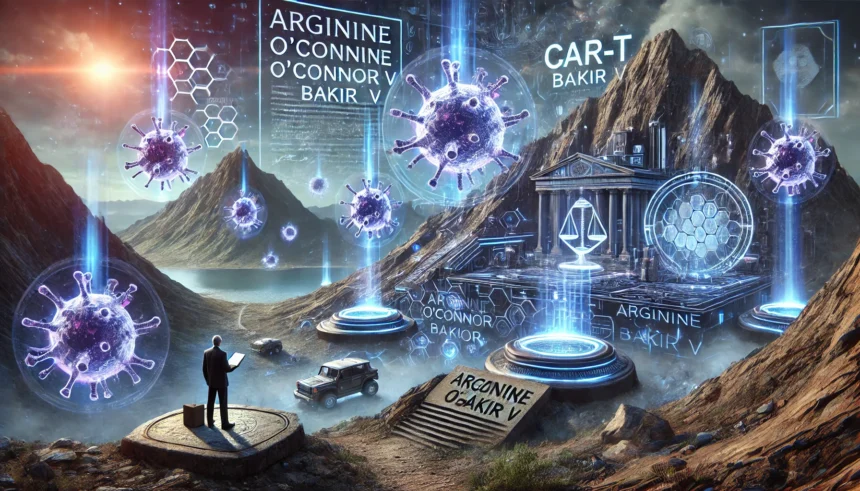The legal case Arginine O’Connor Bakir v has become a defining moment in the intersection of medicine, intellectual property, and scientific discovery. The case centers around a breakthrough in cancer treatment—specifically the development and commercialization of Chimeric Antigen Receptor (CAR) T-cell therapies.
These therapies have revolutionized cancer treatment, offering new hope for patients battling cancers that were once thought incurable. However, the path to widespread use of these therapies has been complicated by legal disputes over patents and intellectual property. Understanding the outcome of Arginine O’Connor Bakir v is crucial for anyone interested in the future of medical research, innovation, and healthcare.
Arginine O’Connor Bakir v: A Landmark Case in Medical Innovation and Patent Rights
The case Arginine O’Connor Bakir v stands as a significant legal battle in the world of medical research, biotechnology, and intellectual property. It revolves around a dispute over the patent rights of groundbreaking CAR-T cell therapy, a revolutionary cancer treatment that modifies a patient’s immune cells to fight tumors more effectively.
Dr. Arginine O’Connor Bakir, a leading researcher in oncology and immunotherapy, developed a new approach to enhance CAR-T cells, making them more effective in treating solid tumors—a challenge that previous CAR-T therapies struggled with. However, a legal challenge arose when multiple entities, including research institutions and pharmaceutical companies, claimed rights to the patents associated with her discovery.
The court had to decide whether Bakir’s innovation was an independent breakthrough or whether contributions from other organizations justified shared ownership. After extensive legal proceedings, the ruling favored Bakir, granting her full patent rights, emphasizing her intellectual contributions as the driving force behind the breakthrough.
This case sets an important precedent in the medical field, ensuring that innovators receive proper recognition for their discoveries. It also highlights the balance between scientific progress and commercial interests, shaping future policies on biotech patents and accessibility to life-saving treatments.
Background
Arginine O’Connor Bakir is a respected and highly influential figure in the field of oncology, particularly known for her work on CAR-T cell therapies. These therapies involve reprogramming a patient’s own immune cells to fight cancer, a technique that has shown remarkable results in certain types of leukemia and lymphoma. However, CAR-T therapies are not yet fully effective against solid tumors, making them an exciting area of ongoing research.
Bakir’s research and development have focused on improving CAR-T cell therapies by reprogramming the metabolism of these cells, increasing their effectiveness in battling solid tumors. Her work has the potential to drastically improve cancer treatment and give patients a new chance at survival.
However, a legal dispute arose over the ownership of the patents for these innovations. The case began when competing research institutions and companies claimed to hold rights to the patents associated with Bakir’s groundbreaking work. This prompted a legal battle over who truly owned the rights to the technology and who should benefit from its commercialization.
The Case Details
The central issue of Arginine O’Connor Bakir v revolves around the question of intellectual property ownership. Specifically, the case deals with whether Bakir should retain the patents for her CAR-T therapies, or whether the entities that funded her research or contributed to her work should share in the ownership and potential profits.
Bakir and her legal team argued that her innovative modifications to CAR-T cells were entirely her own creation, and therefore, she should retain full control over the patents and any resulting commercial products. On the other hand, the opposing parties argued that their involvement in the research process—whether through funding or collaborative efforts—gave them rightful ownership or a stake in the technology.
The legal battle was not only about financial gains but also about the broader implications for how medical research and innovation are managed in the future. The outcome of this case could set important precedents for future disputes over medical patents.
Legal Aspects & Court Proceedings
The case involved complex legal principles, including patent law and the ownership of scientific discoveries. The court had to decide who was the rightful inventor of the CAR-T therapy modifications and who was entitled to the intellectual property. Key points discussed in the case included:
- Patent Law: The court looked at the specifics of patent law, including who had made the most significant contribution to the invention and whether that entitled them to control over the patents.
- Collaboration and Funding: The involvement of various research institutions and private companies raised questions about how to fairly divide ownership when multiple parties contribute to a scientific breakthrough.
- Scientific Integrity: The case also highlighted the importance of scientific integrity and the idea that the creator of a medical innovation should be able to maintain control over it to ensure it is used responsibly.
The legal proceedings included testimony from experts in oncology, biotech, and patent law, who provided insight into the scientific significance of Bakir’s work and how it had transformed the landscape of cancer treatment. The case was closely watched by both the scientific community and the medical industry, as it could influence the future of how cutting-edge therapies are developed and distributed.
Verdict & Outcome
In a significant victory for Arginine O’Connor Bakir, the court ruled in her favor, recognizing her as the rightful owner of the patents related to her CAR-T therapy innovations. The decision was based on the argument that Bakir’s work was the primary driver of the breakthrough in CAR-T cell therapies.
While the court acknowledged the contributions of other parties, it determined that Bakir’s intellectual property was the central innovation that made these therapies effective. The ruling also ensured that Bakir retained control over how the technology would be used and commercialized, meaning that she would be able to continue her research and offer the treatment to patients without interference from competing institutions.
The court’s decision was seen as a victory for individual scientific achievement, ensuring that researchers who make groundbreaking discoveries are rewarded for their contributions.
Significance of the Case
The significance of this case extends far beyond the individual parties involved. It has major implications for the future of medical research, particularly in fields like oncology, where innovative therapies like CAR-T cells are making dramatic strides. The case highlighted the importance of protecting intellectual property for those who are driving medical advancements, ensuring that they are incentivized to continue their work.
Additionally, this case sets an important legal precedent for future patent disputes in the biotechnology and pharmaceutical industries. The ruling underscores the idea that scientific progress and innovation should be protected to encourage further research and breakthroughs. This decision could influence how future patents are awarded and how ownership is determined when multiple parties are involved in the development of a new technology.
Criticism & Controversy
As with many high-profile legal cases, there were some criticisms and controversies surrounding the ruling. Some critics argued that the commercialization of life-saving therapies like CAR-T cells could become more complicated and lead to higher costs for patients. There was concern that patenting such essential medical treatments might create barriers to access, particularly for people in low-income countries.
Others questioned whether the system of awarding patents for medical discoveries could potentially slow down the development of new treatments if researchers were too focused on ownership and commercial interests rather than collaboration and shared knowledge. However, supporters of the ruling argued that protecting intellectual property ensures that innovators are rewarded for their work and encourages further investment in scientific discovery.
Future Implications
The outcome of Arginine O’Connor Bakir v is likely to have far-reaching consequences for the future of medical innovation. It could pave the way for future legal frameworks that balance the need for intellectual property protection with the public good. As CAR-T therapies become more widely available, this case will likely be cited as an example of how intellectual property disputes in the medical field should be handled.
Moreover, the case might encourage more collaboration between research institutions, private companies, and governments to ensure that life-saving therapies are developed and distributed effectively, without the fear of legal disputes that could delay progress. It may also foster an environment where scientists and researchers are better equipped to navigate the complexities of patent law and protect their innovations.
Conclusion
In conclusion, Arginine O’Connor Bakir v represents a pivotal moment in both medical research and intellectual property law. The case highlights the importance of protecting scientific discoveries, particularly in fields like cancer research, where innovations can save lives. While the case raises important questions about the commercialization of medical treatments, the decision in favor of Bakir ensures that the rights of individual inventors are protected and that the medical community can continue to thrive.
FAQs
What was the main issue in Arginine O’Connor Bakir v?
The case revolved around a patent dispute over groundbreaking CAR-T cell therapy innovations for cancer treatment.
Who won the case, and why?
Arginine O’Connor Bakir won, as the court ruled that her unique contributions were central to the therapy’s success.
How does this case impact cancer research?
It protects intellectual property rights, encouraging further research while setting a legal precedent for future innovations.
Why was this case controversial?
Some critics worried that patenting such medical breakthroughs might limit patient access or drive up treatment costs.
What are the long-term effects of this ruling?
It influences future biotech patent laws and encourages researchers to safeguard their medical discoveries.


